Helping dogs have more fun with their humans!
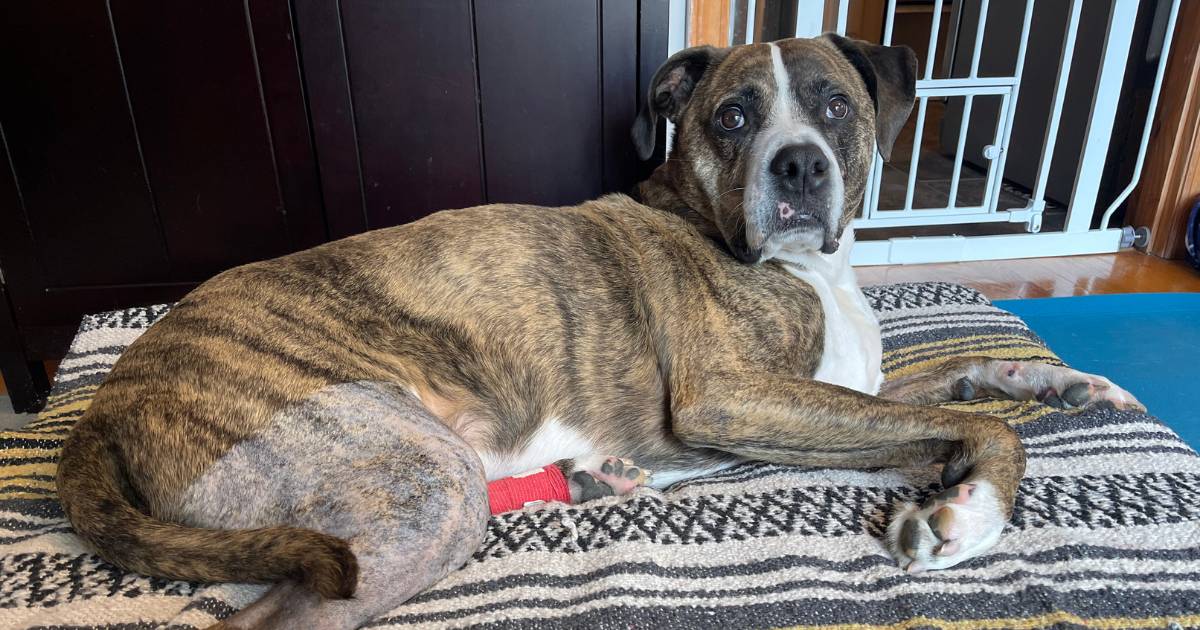

As a dog parent, it’s important to be aware of the potential health issues that can affect our furry friends. One common injury that dogs can experience is a Cranial Cruciate Ligament (CCL) tear. Due to differences in anatomy, the CCL in dogs functions similarly to a human Anterior Cruciate Ligament (ACL). For this guide, we will refer to it as an ACL going forward. We find it is easier to compare dog anatomy to human anatomy, when possible. Similarly to humans, a tear in the ACL can cause pain, lameness, and reduced mobility for our beloved pets.
In this guide, we’ll provide you with essential information to help you spot the symptoms of a torn ACL in dogs and proactive steps to help avoid aggravating the injury. From understanding common causes of ACL tears to learning about prevention strategies and treatment options, this article will give you the knowledge and tools to get you through a difficult injury. Don’t let an ACL tear get your dog down – with proper care and attention, you can keep them on their feet and wagging their tail.
If you’re looking for guidance on recovery from ACL surgery, check out our guide on recovery from ACL surgery for your dog. We draw on our own experience after 3 surgeries to help make your experience as smooth as possible.
Disclaimer
To touch on the obvious, we are not veterinarians, surgeons, or any other dog professional. We’re explaining our own experiences with our pup before his surgeries for educational purposes only. Our goal is to help you recognize the earliest symptoms of a torn ACL in dogs so that you and your pup can have as easy and efficient a recovery as possible. We highly recommend that you get in touch with your veterinarian if you suspect your pup may have an ACL-related injury.
Understanding the (basic) anatomy of a dog’s knee joint
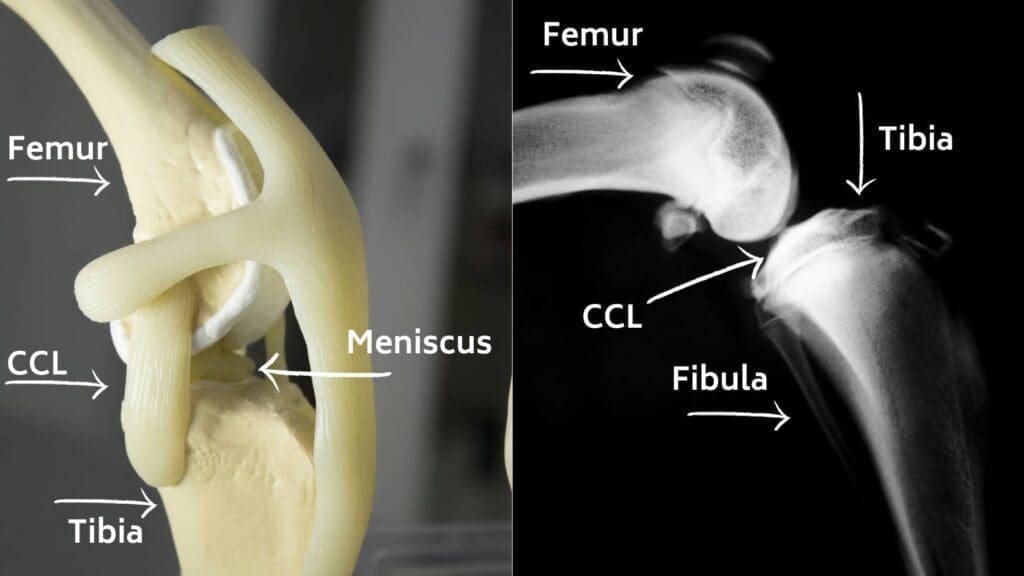

To understand the early symptoms of a torn ACL in dogs, it’s important to have a basic understanding of the anatomy of their knee joint. The knee joint in dogs is similar to the human knee and consists of three primary bones, the femur, fibula, and tibia. The ACL, also known as the cranial cruciate ligament (CCL) in dogs, is responsible for stabilizing the knee joint and preventing excessive movement in the knee. Its function stabilizes the connection between the femur and tibia, the bones above and below the knee, respectively. When the ACL is torn, the knee joint becomes unstable, leading to pain and reduced mobility.
An ACL tear is one of the most common knee injuries in dogs, especially in larger breeds. It often occurs as a result of sudden twisting or overextension of the knee joint. Additionally, older dogs may be more prone to ACL tears due to age-related degeneration of the ligament. Understanding the anatomy of a dog’s knee joint and the role of the ACL is crucial for recognizing the early symptoms of a torn ACL in dogs and seeking appropriate treatment.
Common causes of ACL tears in dogs
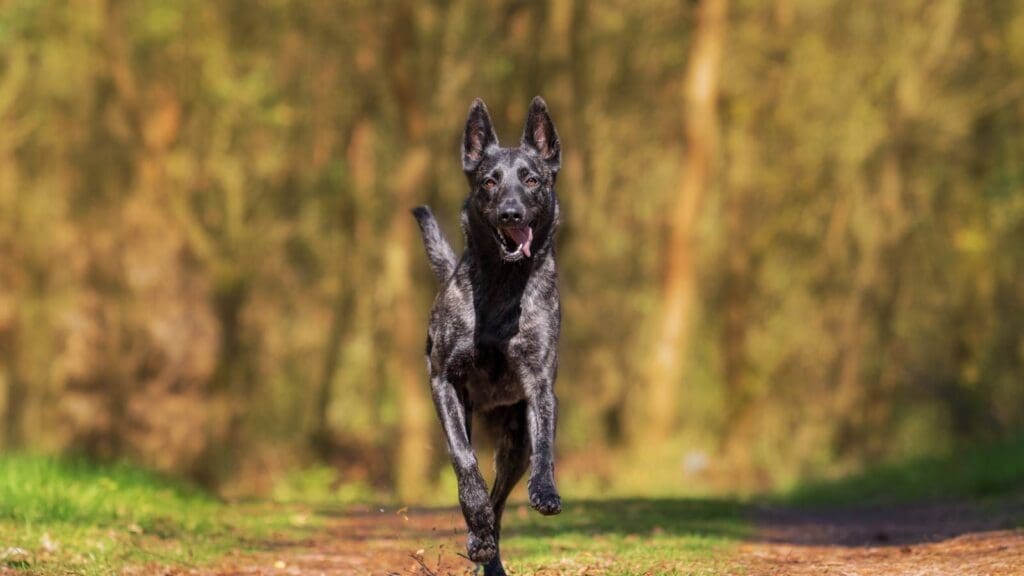

While a torn ACL in dogs can occur in all ages and breeds, certain factors can increase the risk of this injury. Understanding the common causes of ACL tears can help you take preventive measures to protect your dog’s knee joint, which can reduce the risk of injury and make recovery from a potential injury easier.
One of the primary causes of ACL tears in dogs is abrupt changes in direction or intense physical activity, such as jumping or chasing. These movements put significant stress on the knee joint, increasing the likelihood of a tear. We’re not saying don’t play fetch with your dog, but if you have an intense play session, make sure your pup gets some rest to allow their body to recover adequately. For us, Goomba tore his ACL when he was playing with his favorite toy in our backyard.
This is by far Goomba's favorite toy and it isn't even close! It lasts a surprisingly long time, even with a power chewer like him. It's weather-resistant and he still loves it even after he managed to damage the squeaker. This is one of the toys we use for him as a reward for training and it works great!
Additionally, weight can contribute to the development of ACL tears in dogs. Excess weight puts extra strain on the knee joint, and every other joint, making it more susceptible to injury. Other risk factors can include genetic predisposition, such as certain breeds/shapes of dogs being more prone to ACL tears, and pre-existing joint conditions like arthritis. By being aware of the signs of a torn ACL in your dog, we can minimize the impact of an injury and get your pup back to chasing squirrels and playing as soon as possible.
Recognizing the early symptoms of a torn ACL in dogs
Early detection of an ACL tear is crucial for effective treatment and preventing further damage. While dogs cannot communicate their pain verbally, they do exhibit signs that can indicate an ACL tear. If you have an idea of what to look for, you can head off the hardest parts of recovery – in our experience, the development of arthritis and loss of muscle, also known as muscle atrophy.
During Goomba’s injury, atrophy has been by far the most involved part of recovery. Goomba doesn’t generally show much pain or discomfort, so by the time we were able to discover he had an issue, it was much later than we would prefer. The result for Goomba, and us, was a lot of physical therapy and work to build muscle in his rear legs. Even with the most compliant dogs, like Goomba, it’s not easy to get your dog to do physical therapy movements.
Abnormal gait
This is one of the easier symptoms of a torn ACL in dogs to catch early, but just because your pup is limping one day doesn’t mean they tore their ACL. Pay attention to how they move over a few days. For us, the most obvious sign was twisting through the spine.
Normally, when we or our dog walk, the spine stays relatively aligned. If something makes a leg or foot sensitive, the body starts manipulating their movement so there is less weight on the injured extremity. This may come off as walking with a curve in their spine or rolling their spine. Goomba did both during his pre-surgery and recovery periods. In the above video, this is a more extreme example, as it was shortly after his traumatic event.
We found it hard to tell which limb is injured if your dog is still walking at a normal speed with an injury. We recommend using the next two symptoms to get a better idea of which leg is affected. It will provide a precise symptom out of many symptoms of a torn acl in dogs.
Uneven weight distribution
Testing for uneven weight distribution is an easy way to get quality information about your pup. The test is simple: pick up your dog’s feet one at a time, if they allow you to do so. What you’re looking for is a leg (or two, if you’re unlucky) that has significantly less weight than the others. It shouldn’t be difficult to tell if there is uneven weight distribution. If you have to think about it, it’s probably close enough to normal to not point to an issue. This is another sign that should be a pattern, not just a one-time event. If your pup isn’t looking straight ahead or stops in an asymmetrical stance, check again later.
In our experience, Goomba began using his front legs to support over 80% of his weight, instead of closer to 50%. Checking for uneven weight distribution can help tell you that something is causing your pup to put less weight on the limb. We still do this test today if we suspect our pups may have injured an extremity or the bottom of a foot.
Abnormal sitting


Abnormal sitting is another symptom of a torn ACL in dogs. This is a direct symptom of a torn ACL that should be an observed pattern, not a single event. Dogs with an injured ACL will typically flare their knee out to the side. Instead of looking like Prim (left) when she’s sitting “on her skis,” the positioning will appear more like Goomba (middle) with a leg that is not under their body.
Another good sign is if your pup is sitting on their hip. This is typically done to eliminate weight placed on the leg being sat on. Sometimes, you’ll get a lazy pup, like our Prim, who has nothing wrong but ends up on her hip because she melts into the couch. If there is a pattern of sitting on one hip, especially the same one, it’s a specific behavior to keep an eye on.
Difficulty with elevated surfaces
This symptom overlaps heavily with uneven weight distribution and abnormal gait. As you can imagine, walking up steps or inclines is difficult if your pup is not using their back legs normally. We saw Goomba doing a lot of twisting to try to minimize the weight on the injured leg – to the point that it was obvious something was not right, even without any other symptoms.
For us, especially after long periods of being stationary (crate times, napping in the evening, etc), Goomba was stiff for longer than we thought was normal. With steps, he would take the first half of the steps awkwardly until he was about halfway up and then would walk normally. He’d eventually get moving closer to a normal movement, but would consistently take more time to transition from lumbering to his normal gait and there was still a lot of twisting and head movement
We (and our pups) love this foldable ramp! It doesn't take up much space, is easy to move, and is sturdy. We use it for various agility movements, to help get Prim in the tub, and when Goomba had multiple leg surgeries. We don't think there is a better value for a safe ramp than PetSafe's ramp!
- Easy to move
- Siderails & non-slip surface help keep your pup on the ramp
- High weight capacity
- Weather resistant
- Not the best ramp for tall vehicles
We recommend using an inside dog ramp when it’s possible to help minimize any issues, even if your pup didn’t injure their ACL.
Difficulty getting up
Similar to difficulty with elevated surfaces, difficulty getting up is another good indicator that your pup may have something going on with their knee. If your pup has an uneven distribution of weight, getting up becomes much more challenging. We would see Goomba trying to go from lying down to standing essentially by only using his front legs. If he was on a smooth floor, this would result in sliding due to the amount of weight he was putting on his front legs, and generally seemed like an awkward motion.
This was one of the earlier symptoms of a torn ACL in dogs for us, but we thought he was just sore or tired from playing. We didn’t know better at the time, but it’s much more obvious looking backward now.
Muscle atrophy
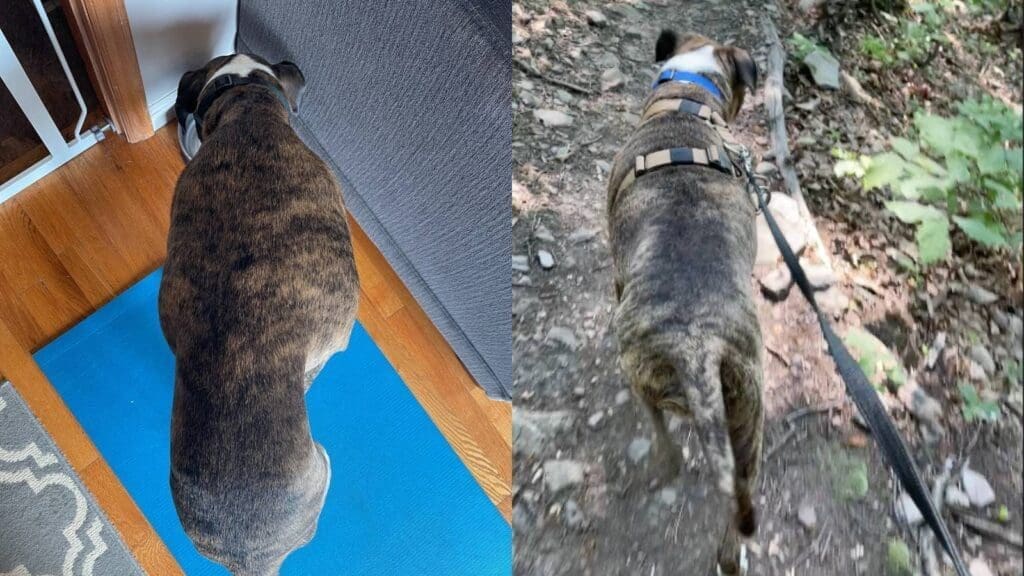

Of all of the symptoms of a torn ACL in dogs, atrophy (muscle loss) is the hardest to notice and the hardest to recover from. Goomba doesn’t generally show discomfort, so by the time we noticed the uneven distribution of weight in his legs, he had already experienced quite a bit of atrophy. The only way to reliably tell is by comparing two images side by side from different times. Make sure that you are comparing to a past photo of your pup in their current size (normal weight) for the before picture. Compared to their puppy picture won’t tell you much and the same applies to a much heavier or lighter dog.
It is surprisingly hard to notice muscle atrophy without comparing snapshots in time because the process occurs through small gradual changes to your dog’s physique. Don’t be too hard on yourself for “not noticing sooner” that something was wrong! The important thing to do is keep making an effort to help your pup now that you suspect an issue.
For us, we had a picture of when Goomba was around 4 and could easily tell the difference compared to when he was around 6. The left is after we became aware of atrophy and the right was somewhere close to 2 years later. You can see that his rear half has less muscle (due to not using his rear legs as much) and his front half has more muscle. As a note, the left picture is slightly exaggerated because of him shifting his weight off the left side. Even so, with similar angled photos, you can tell the difference between the before and after pictures easily.
The frustrating part of this is that you’ll have to convince your dog to use their back legs normally again. After that, it’s a waiting game. Just like if humans try to build muscle, it’s a slow, gradual process, not something you can force overnight. We’re still working with Goomba to try to help him more muscle in his rear legs.
Traumatic event
The most obvious symptom that could indicate an ACL injury for your dog is a traumatic event. For us, Goomba was running in our yard after one of his favorite toys when he yelped and would not use one of his legs to support himself. This is typically one of the later signs that could indicate a torn ACL, and we were able to see that almost all of the other signs were presented before his first traumatic event.
As a word of caution, even extremely friendly dogs can get very defensive in a situation where they have a painful injury. We’re big advocates of muzzle training your dog, even if you don’t think you’ll ever use it. We’ve heard so many stories of friendly pups lashing out because they’re scared and have no idea what happened to their leg. A muzzle may be helpful to allow calm and safe care to be provided to your pup by you or your vet and a lot of vets will require it in instances like this.
Swelling/pain
When Goomba tore his doggy ACL, we were able to notice this symptom after the traumatic event. We’re very confident that we would have noticed the significant swelling or pain even without the traumatic event as an indicator. After he yelped, we were able to tell that it was something in his knee region due to the swelling and general sensitivity in that area. He also kept grooming his knee, over his normal licking. If your pup has swelling or pain around their knee and tends to be over-grooming that region, we highly recommend that you go to your vet as soon as possible.
If it’s an ACL-related injury, the sooner it is addressed, the easier your dog’s (and your own) time will be during recovery.
Cracking or popping sounds
Another easily observed symptom of a torn ACL in dogs is a cracking or popping sound. When your dog damages their ACL, their meniscus is typically damaged as well. This was the case for 1 of the 2 rear legs for Goomba. It produced an audible cracking sound when he would walk up inclines. While not a definitive sign, this can help reinforce suspicion of an ACL injury and is a helpful clinical sign to share with your vet.
Preventing further damage to the ACL
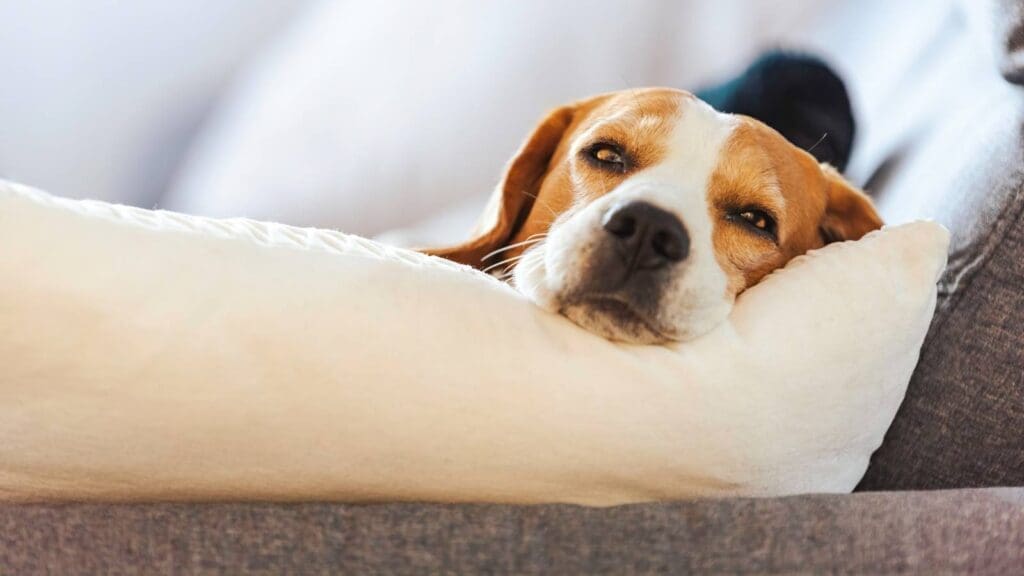

If you have recognized some of the symptoms of a torn ACL in your dog, it’s crucial to take preventative measures to avoid further damage. One of the most important steps is managing your dog’s activity level. Restricting high-impact activities, such as running, jumping, and playing on uneven surfaces, can help protect the knee joint and prevent further injury or arthritis development. Instead, focus on low-impact exercises and controlled walks to keep your dog active without putting excessive stress on the knee. If your pup is extremely active when you’re not home, crate training can help, even if you only use it during the time you’re away.
Maintaining a healthy weight is also essential for preventing further damage to the ACL. Extra weight puts additional strain on the knee joint, which will make every movement harder for your dog and their joints. Consult with your veterinarian to develop a balanced diet and exercise plan that promotes weight management and overall well-being. Regular veterinary check-ups are also recommended to monitor your dog’s joint health and address any potential issues before they worsen. Early intervention is key to minimizing damage and recovery time.
It’s not hard to modify your dog’s activity until you’re able to get checked out by your veterinarian. For example, you can change high-impact activities like sprinting and jumping to doing some of the low-impact agility obstacles, like an agility tunnel. Other mentally stimulating activities such as lick mats or snuffle mats can help as well. We used both of these consistently with Goomba, since his downtime was a bit longer than most dogs.
Diagnosing an ACL tear in dogs
If you suspect that your dog may have an ACL tear, it’s crucial to consult with a veterinarian for an accurate diagnosis. The veterinarian will perform a thorough physical examination of your dog’s knee joint and may recommend additional diagnostic tests, such as X-rays, to confirm the diagnosis. These tests help determine the extent of the injury and rule out other potential causes of lameness or joint pain.
During the physical examination, the veterinarian will assess the knee joint, looking for signs of increased movement or instability. They may also perform specific manipulations, known as drawer and tibial compression tests, to evaluate the condition of the ACL. Based on the findings, the veterinarian will provide a diagnosis and recommend appropriate treatment options. In our experience, a skilled veterinarian can form an accurate diagnosis from the drawer test before having to perform any imaging on your pup.
Treatment options for ACL tears in dogs
The treatment for an ACL tear in dogs depends on various factors, including the severity of the injury, the size and age of the dog, and the dog’s activity level. In some cases, conservative management may be sufficient, especially for small dogs, dogs with partial tears, or dogs who aren’t able to be sedated safely. Conservative management typically involves rest, pain management, and physical therapy to strengthen the surrounding muscles and support the knee joint.
For more severe or complete ACL tears, surgical intervention may be necessary. There are several surgical techniques available, including extracapsular repair, tibial plateau leveling osteotomy (TPLO), and tibial tuberosity advancement (TTA). These procedures aim to stabilize the knee joint and restore normal function. The choice of surgery depends on various factors, and the veterinarian will recommend the most suitable option for your dog based on their individual needs. When discussing surgical options for Goomba, we found some surgeons specialize in or only perform one specific type of repair. If you or your primary veterinarian determine that one option is superior, some research may be necessary to make sure you can find a surgeon who performs that specific procedure.
Tips for managing a dog with an ACL tear
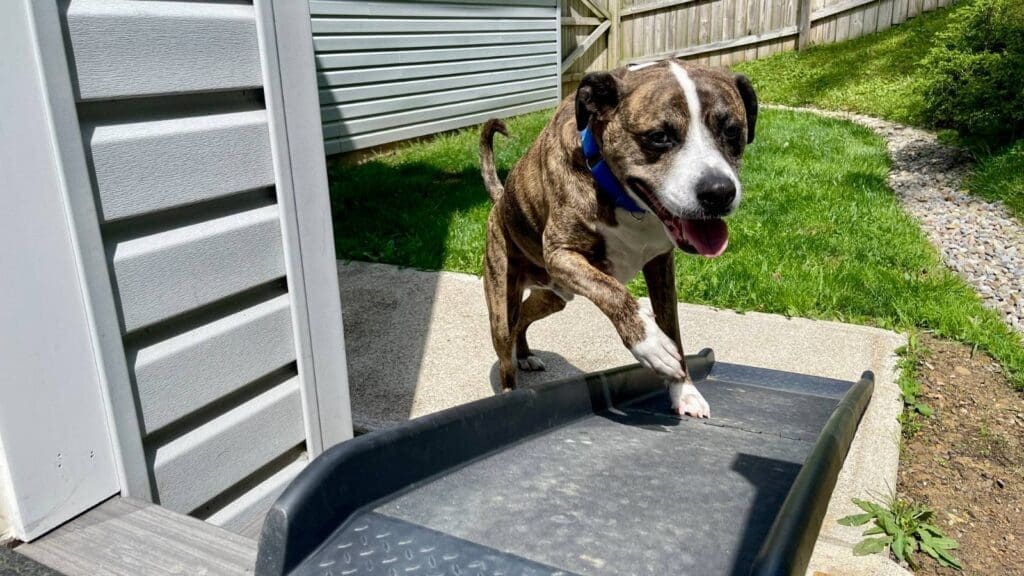

Caring for a dog with an ACL tear requires patience, dedication, and proper management. Here are some tips to help you navigate this challenging time:
1. Follow your veterinarian’s instructions: Whether your dog undergoes surgery or conservative management, it’s crucial to follow your veterinarian’s recommendations regarding medication, rest, and physical therapy.
2. Provide a safe and comfortable environment: Create a comfortable space for your dog to rest and recover. Consider using orthopedic bedding or providing extra padding to alleviate pressure on the injured leg. We find that making it harder for your dog to fail goes a long way toward helping your dog be as comfortable as possible.
3. Assist with mobility: Depending on the severity of the injury, your dog may require assistance with mobility. Use a sling or harness to support the hind end and help them navigate stairs or get in and out of the car. If this is not an option for you, a portable dog ramp is a great alternative.
We (and our pups) love this foldable ramp! It doesn't take up much space, is easy to move, and is sturdy. We use it for various agility movements, to help get Prim in the tub, and when Goomba had multiple leg surgeries. We don't think there is a better value for a safe ramp than PetSafe's ramp!
- Easy to move
- Siderails & non-slip surface help keep your pup on the ramp
- High weight capacity
- Weather resistant
- Not the best ramp for tall vehicles
4. Monitor for signs of complications: Keep a close eye on your dog’s injury site for any signs of complications. Contact your veterinarian immediately if you notice redness, swelling, discharge, or excessive licking. Early intervention is crucial for a smooth recovery.
5. Be patient and supportive: Recovery from an ACL tear takes time, and your dog may experience ups and downs along the way. Provide plenty of love, support, and encouragement to help them through the healing process. Remember: your dog doesn’t understand what happened to them.
Final thoughts
An ACL tear can be a challenging experience for both dogs and their owners. However, with early detection, proper treatment, and preventative measures, you can help your furry friend recover, prevent further damage to the knee joint, and get back to full activity as quickly as possible. Understanding the anatomy of a dog’s knee joint, recognizing the early symptoms of an ACL tear, and seeking prompt veterinary care are essential steps in ensuring the best possible outcome for your dog. Remember, your dog relies on you for their well-being, so stay aware and provide the care and attention they deserve.
Do you have other symptoms of torn ACL in dogs that we didn’t mention? Every dog is different! Share your observations with us on Instagram by tagging @therulybully.
Have fun!





